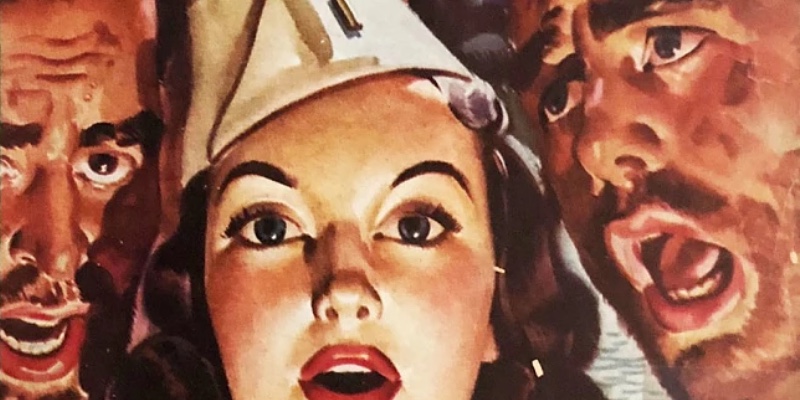“Who knows what evil lurks in the hearts of men? The Shadow knows …” /
Insert sinister laugh here.
The Shadow, a proto-Batman who, unlike the Caped Crusader, was more than willing to gun down the bad guys, began as a character on a 1930 radio show and then backtracked into his own pulp magazine the following year.
The shadowy crimefighter is probably the best-known pulp hero, but those cheap magazines delivered hundreds of heroes and villains into the hands of eager readers for much of the first half of the 20th century. Heroes like the Shadow and Doc Savage and the Avenger are remembered today – if they’re remembered at all – for their reincarnations in paperbacks and comic books beginning in the 1960s.
But other mainstays of pulp fiction – to coin a phrase – included cowboys, detectives, secret agents, scientists, barbarians and even private investigators, many of them among the most-beloved characters in genre literature.
Pulp magazines, also known as “the pulps,” were born out of publishers’ determination to make as much money as possible, so they were printed on the cheapest pulpwood paper. The writers of the pulps churned out hundreds of novels and stories for a few bucks apiece.
Two hundred separate pulp titles were regularly published in the Depression years, according to “An Informal History of the Pulp Magazine,” Ron Goulart’s indispensable 1972 history of the pulps. In “The Black Lizard Big Book of Pulps,” the hefty 2007 collection of pulp fiction, editor Otto Penzler raised that ante, saying that more than 500 titles a month were published.
The pulps took the country by storm, filling the era between dime novels and comic books and, later, paperbacks. But because they were printed on the most disposable of paper and written and illustrated as cheaply as possible for New York publishing houses, they were, in their paper form, short-lived by design. When they were gone, they were gone.
But the pulps, somehow, live on.
Unlikable father of the pulps
It’s not the sometimes-turgid prose or outlandish plots that keep pulps alive, at least in some segments of the population, today.
No, it’s the characters. And some of the most memorable characters were those who created and produced the pulps.
“Nobody liked Frank A. Munsey,” Goulart wrote in his guide to pulps, regarding the man considered the father of the format. Munsey, who died in 1925, was a money man, not a creative type. He bought up magazines and newspapers and tried to capture the public tastes of the day. Goulart notes that Munsey ruthlessly canceled his newspapers and magazines when they failed to generate enough revenue.
Munsey printed his magazines on cheap wood-pulp paper and shipped them out with the ends untrimmed, solidifying the image of pulps. He founded Argosy magazine in 1888, publishing adult fiction following Argosy’s run as a children’s magazine, and it was one of his most lasting successes, publishing until 1978, more than a half-century after his death.
Probably because of his desire to generate the largest-circulation magazines possible at the lowest cost, Munsey joined other publishers specializing in printing fiction. Writers, who were paid pennies or fractions of pennies per word, earned $10 or a little more for a novel-length story for Munsey or other publishers, could churn out fiction at an astonishing pace: Walter B. Gibson, ghostwriter and friend of magicians like Harry Houdini, wrote 112 book-length shadow stories between 1931 and 1936. When the Shadow magazine shut down in 1949, Gibson had written 280 novels about the character, Goulart wrote.
Argosy sold a half a million copies a month in the early 1890s, Goulart wrote. In the first dozen successful years of Munsey’s publications, Munsey’s and Argosy, the publisher made a net profit of nine million dollars.
Murderous cats and deep-sea corpses
The characters in the pulps were introduced to readers by the covers of the pulps. Those lurid covers were, not surprisingly, the strongest selling point of pulps from Munsey and other publishers. The covers were a riot of color, with cowboys and detectives wielding weapons and damsels threatened by murderous creeps. All-Story Detective, which didn’t debut until 1949, really seemed to specialize in putting women in danger. The covers of the earliest issues are a parade of women reacting with open-mouthed terror to knives being thrown at them or thrust at them or guns pointed at them.
Black Book Detective, first published in 1933, ran for 20 years. Square-jawed men and menaced women, often blondes in red dresses, were featured on the covers, while a masked crimefighter known as the Black Bat hovered in the background beginning in 1939 – the same year Batman debuted in Detective Comics, a straight comic book for DC.
The titles of the featured stories in the pulps were insanely creative – or just insane. “The Cat Mews Murder” headlined the pulp titled Speed Mystery. “Hot Lead Hurricane” led off an issue of Red Seal Western. “Murder Can’t Be Drowned” – illustrated by a great cover of a deep-sea diver discovering an underwater skeleton with a knife stuck in its ribs – would have made Dime Detective Magazine a sure purchase for adventure lovers.
Since the paper, stories and that vivid art of the pulps were so cheap, many of the issues were huge: Munsey’s Argosy reached nearly 200 pages in a typical issue. For a dime, those thick pulps were seen as a great buy.
“I grew up reading pulps,” author Harlan Ellison wrote in an introduction to a section about villains in “The Black Lizard Big Book of Pulps.” “I was born in ’34, and unlike most of the Jessica Simpson-admiring twerps of contemporary upbringing, for whom nostalgia is what they had for breakfast, I actually remember what a hoot it was to plunk myself into the Ouroboros root-nest of the ancient oak tree in the front yard of our little house at 89 Harmon Drive, Painesville, Ohio, with the latest issue of Black Book Detective Magazine or the Shadow. Ah me, those wood-chip-scented, cream-colored pulp pages dropping their dandruff onto the lap of my knickers …”
After railing on for a few hundred words about how 21st-century entertainment was lacking compared to that of decades before, Ellison allows that when read today, “The (pulp) fictions may creak a bit in the joints, some of the writing may be too prolix for modern tastes (don’t forget, they were writing for a ½ cent to a penny per word in those halcyon days of post-Depression America) and we have been exposed to an electronically-linked world for so long now, that some of the attitudes and expressions in these fables may seem giggle-worthy, but this is a muscular writing that sustained us through some very tough times, and their preserved quality of sheer entertainment value is considerable. So be kind.”
Jellyfish and dames at breakneck speed
The Black Mask pulp alone has a tremendous legacy of great crime writers, Penzler noted in the “Black Lizard” pulp compendium.
“Every significant writer of the pulp era worked for Black Mask, including Paul Cain, Horace McCoy, Frederick L. Nebel, Raoul Whitfield, Erle Stanley Gardner, Charles G. Booth, Roger Torrey, Norbert Davis, George Harmon Coxe and, of course, the greatest of them all, Raymond Chandler,” Penzler wrote.
In a 1932 edition of Black Mask, in the story “Honest Money,” Gardner introduced an attorney, Ken Corning, a character that would be perfected when Gardner later created lawyer Perry Mason. Gardner didn’t stint on the vivid writing as he described a would-be client that came to Corning’s office, which was so new the attorney’s name had just been painted on the door.
“He looked as though his clothes had been filled with apple jelly…He quivered and jiggled like a jellyfish on a board. Fat encased him in layers, an unsubstantial, soft fat that seemed to be hanging to his bones with a grip that was not temporary.
“His voice was thin and falsetto.
“’I want to see the lawyer,” he shrilled.
And how about this, in Dime Detective in January 1938, from Raymond Chandler, set in a California cocktail lounge where Philip Marlowe has just settled on a barstool.
“The kid behind the bar was in his early 20s and looked as if he had never had a drink in his life…Marlowe looked around the room and observed a miserable-looking souse.
“You sure cut the clouds off them, buddy, I will say that for you,” Marlowe told the bartender.
“We just opened up,” the kid said. … “I ought to call a taxi and send him home. He’s doing his next week’s drinking too soon.
“A night like this,” I said. “Let him alone.”
In the “Black Lizard” book, the great Laura Lippman introduces a section of stories about women in pulps and acknowledges that “the pulps of the early-twentieth century will never be mistaken for proto-feminist documents.” She cites the then-recent incident of an astronaut who, wearing a diaper and armed with a knife, gloves and garbage bags, drove 800 miles to “confront a romantic rival.” The astronaut was a woman, Lippman notes, and so was her potential victim, who spoiled the scheme.
“All I know is that I prefer the company of the dames within these pages, who parade before us in impeccable suits, filmy negligees, torn evening dresses and … a voluminous purple kimono worn over a corset. But not a diaper, never a diaper, thank God. Even the most venal among them have more class than that.”
In his “Informal History,” Goulart notes, “Nobody noticed it at the time, but the pulp magazine was one of the casualties of the second world war. The mystery men chuckling in their capes and the bronze geniuses leaping out of penthouses didn’t fit very well in the world as it was after Hitler and Hiroshima.”
Goulart notes that paperbacks, comic books and later, television, provided different shapes of romantic and adventurous escape.
The pulp writers, great and not-so-great, left behind some memorable writing, but as Penzler noted, “The writers mainly had the goal of entertaining readers when these stories were produced. … stories written at breakneck speed and designed to be read the same way.”

















